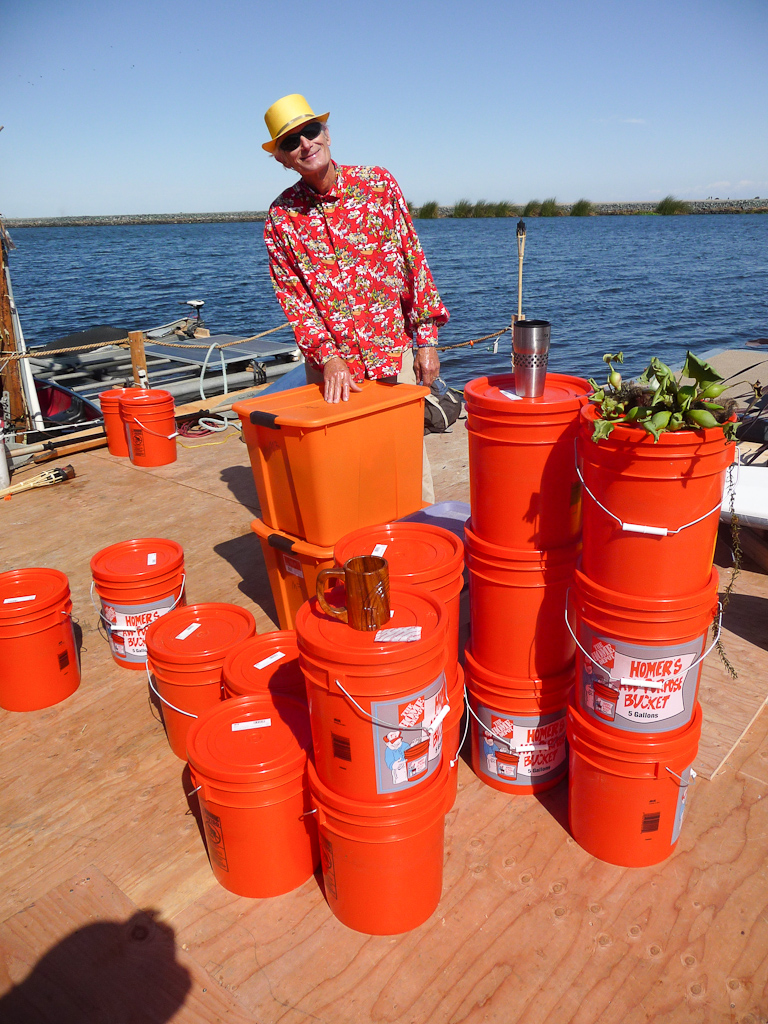Floatation Research
This page describes various methods of floating a large (~20’x20’), stable, and safe platform for public use at Ephemerisle.
Design constraints:
- Use materials that are as inexpensive as possible while still being reliable.
- Favor reusable materials over one-time-use materials that will be discarded.
- Build a platform that is continuous and relatively rigid over its entire size, as opposed to made up of free-floating segments.
- The platform must be launchable from a boat, and therefore modules must be connected together primarily in the water. All fastening in the water must be doable from the top (e.g., no underwater bolt fastening). Also, as much construction work as possible should be done prior to loading the materials on the boat that will be used for launch (e.g., no caulking at final assembly time).
See more on Ratha’s page.
Heavy Duty 27 gallon bins
- Pros: Easily available (Home Depot Tough Box 27-Gallon Tote), affordable ($13), stackable for transport, lots of lift
- Cons: Will leak, or will take lots of labor to seal.
- Cost: 20lbs of lift per $.
- Used to build the 2011 Community Platform
Plastic Bins
- Pros: [http://www.homedepot.com/h_d1/N-5yc1v/R-100551892/h_d2/ProductDisplay?langId=-1&storeId=10051&catalogId=10053 Easily available], cheapest, stackable for transport
- Cons: Flimsy, can crack, and tops can pop off if not secured, may not provide enough flotation, may leak if not sealed with sealant or plastic bag.
- Cost: 20lbs of lift per $
Home Depot Orange Bucket

- Pros: [http://www.homedepot.com/webapp/wcs/stores/servlet/Search?keyword=homer+bucket&langId=-1&storeId=10051&catalogId=10053 Easily available], cheap, stackable for transport, solidly built, can possibly tape buckets together into pontoons.
- Cons: Low floatation per bucket; will need lots of buckets. Leak.
- Cost: 12lbs of lift per $
5 gallon buckets (take 2, with gasketed lids)
- Pros: Easily available, cheap, stackable for transport, solidly built, can possibly tape buckets together into pontoons, and they can be gotten for free. Gasketed lids ($1.25-$2.50) can used to provide a water tight seal.
- Con: It takes lots of buckets to float a platform.
- Cost: 30lbs of lift per $ with free bucket and lids bought in quantity. 10lbs of lift with retail home depot buckets and lids from ace hardware.
55 gallon barrels
- Pros: Can be found for free, rock solid.
- Cons: Big, heavy, hard to transport, will leak if not sealed, must carefully seal and test pre-event.
- Cost: $0
EPS Foam
- Pros: Can be ordered in custom sizes, no problem with leakage, reasonably priced, relatively easy to attach.
- Cons: $250 minimum order. Takes up quite a bit of space for transport and storage.
- Cost: 10lbs of lift per $.